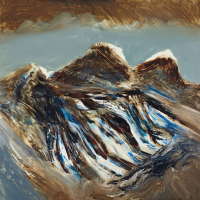21. SIDNEY NOLAN

Nolans Antarctica is the anxious and apprehensive land; the paint is clogged, swirled, cluttered, the spirit troubled.
Elwyn Lynn, September 1965
Sidney Nolan was captivated by places that were vast, remote and often inhospitable. Antarctica was one such place, and in 1964 Nolan finally had the chance to visit, fulfilling a childhood dream. Casting himself in the role of explorer, Nolan used the opportunity to develop a remarkable series of paintings that filtered his own keenly felt observations, and the occasional hair-raising experience, with the so-called Golden Age of Exploration (made famous in the early 20th century accounts of Mawson, Shackleton and Scott). There are over sixty paintings in Nolans Antarctic series, and they are now regarded as some of Nolans finest and most intriguing landscapes. The works traverse a small part of Antarctica and invite a fuller appreciation of its uniqueness and fragility.
In January 1964, Sidney Nolan and the writer Alan Moorehead flew to Auckland, New Zealand, to start an eight-day tour of Antarctica. Moorehead was to gather material for an essay for the New Yorker and Nolan was commissioned to provide the illustrations. The two were transported down to the American base at McMurdo Sound on an uncomfortable six-hour flight on a Hercules aircraft. Located on the southern end of Ross Island, McMurdo was one of three US bases, the others being at the South Pole and Byrd Island in West Antarctica. Nolan and Moorehead spent much of their time around the base camp, exploring Ross Island, and adjacent areas by foot and by helicopter. In addition, they were flown to inland bases, including the South Pole.
Even though their time in Antarctica was brief, Nolan and Mooreheads responses contrasted with many of the common perceptions of Antarctica. From being initially overwhelmed with the unique landscape, the writer and the painter began to draw out some of the differences and similarities they encountered. Nolan noted the appearance of black, basalt peaks that created mirages in the sky, rather than the frothy white peaks of the European Alps. He was also surprised by the abundance of unique patterns and a rich variety of colours and the presence of dry, windy valleys that reminded him of the Australian desert.
Nolan developed two main approaches to what he saw. The first was to try and develop a new visual language for the awe and wonder that matched the experience to wed fidelity to nature with technical bravura seen in his experimentation with more painterly techniques and the use of recently adopted materials such as Rowneys Gel that gave his surfaces a greater translucency. The second was to convey the bravery, resilience and the fragility of the early Antarctic explorers and to relate their stories to those of other heroic figures he admired.
Glacier, Antarctica was one of three paintings that Nolan commenced in his Putney studio on the evening of 1 September 1964. By this time, Nolan was deeply ensconced in the Antarctic series. He sometimes produced up to six new works a day. Glacier, Antarctica relates directly to a flight over The Dry Valleys and conveys what Moorehead described as Glaciers that are pitted and ruffled by the wind, like a choppy sea, creep[ing] down from their sides to the open ocean 1 Nolan recorded in his diary that he had introduced caramel tones into the three paintings commenced on the 1 September.2 The contrasting tan and blue stripes in each of these pictures create a strong sense of a majestic movement in which the ice floe gathers momentum and reaches a crescendo towards the bottom of each slope.
This more radical sense of nature in perpetual flux of the Antarctic continent constantly undergoing a process of change from one moment to the next defied the conventionally held view of Antarctica as a frozen continent bereft of life and is one of the many reasons why these works are so highly regarded and appreciated today.
Footnotes:
1. Moorehead, A., Australian Womens Weekly, 22 September 1965.
2. Nolan, S., diary entry, 1 September 1964, courtesy of The Sidney Nolan Trust, in the possession of the author.
Rodney James, BA (Hons), MA